 University of Tennessee
University of Tennessee
Department of Materials Science & Engineering
|
MSE 614 Course Website
Modeling & Simulation in Materials Science & Engineering: Classical Mechanics
Department of Materials Science & Engineering
University of Tennessee at Knoxville
Instructor: Prof. David Keffer
|
References
|
|
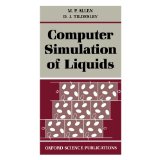 Computer Simulation of Liquids by M.P. Allen & D.J. Tildesley, Clarendon Press, Oxford, 1987.
Computer Simulation of Liquids by M.P. Allen & D.J. Tildesley, Clarendon Press, Oxford, 1987.
The widely popular book was really the first "how-to" book for molecular simulation (both molecular dynamics and Monte Carlo). It is practical and readable. Of course it is dated in that doesn't describe topics of parallel computer architectures nor does it cover any of the advanced techniques developed in simulation after 1987. However, the fundamental basis of molecular dynamics has not changed since 1987. All of the concepts in this book are still true today and must be understood before one ventures into more advanced topics.
|
|
|
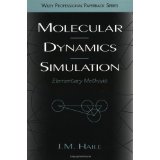 Molecular Dynamics Simulation: Elementary Methods by J.M. Haile, John Wiley & Sons, Inc., New York, 1992.
Molecular Dynamics Simulation: Elementary Methods by J.M. Haile, John Wiley & Sons, Inc., New York, 1992.
The beauty of this book is that it serves as a self-contained introduction to the concepts and implementation of molecular dynamics. It includes in the appendices a complete (serial) code in FORTRAN for MD simulation of a single-component Lennard-Jones fluid. It is both theoretically rigorous and practical. It also has a sentimental value to the instructor of this course because when he was a graduate student, his advisor told him to go "learn molecular dynamics". In 1992, this was one of two available books on the subject. The instructor of this course taught himself MD simulation almost exclusively from this book.
|
|
|
 Understanding Molecular Simulation: From Algorithms to Applications by Daan Frenkel & Berend Smit, 2nd Ed., Academic Press, San Diego, 2002.
Understanding Molecular Simulation: From Algorithms to Applications by Daan Frenkel & Berend Smit, 2nd Ed., Academic Press, San Diego, 2002.
This book essentially provides an update to Computer Simulation of Liquids, providing numerous advanced techniques for MD simulations. It is well referenced and graduate students wanting to implement a particular technique frequently use it as a starting point in identifying critical papers in the literature, which introduced and/or developed the technique.
|
|
|
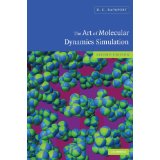 The Art of Molecular Dynamics Simulation by D.C. Rapaport, 2nd Ed., Cambridge University Press, Cambridge, 2004.
The Art of Molecular Dynamics Simulation by D.C. Rapaport, 2nd Ed., Cambridge University Press, Cambridge, 2004.
This book provides a practical introduction to the basic issues associated with classical molecular dynamics simulation.
|
|
|
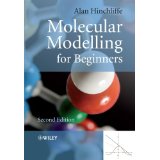 Molecular Modelling for Beginners by Alan Hinchliffe, 2nd Ed., John Wiley & Sons, Inc., New York, 2008.
Molecular Modelling for Beginners by Alan Hinchliffe, 2nd Ed., John Wiley & Sons, Inc., New York, 2008.
This book provides an introduction to the physics as well as a description of simulation, including simulations based on both classical and quantum mechanics. Of the twenty-four chapters in this book, only the first six are relevant to classical molecular dynamics. A majority of the book is devoted to quantum models.
|
|
|
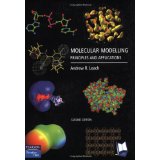 Molecular Modelling: Principles and Applications by Andrew R. Leach, 2nd Ed., Prentice Hall, Harlow, England, 2001.
Molecular Modelling: Principles and Applications by Andrew R. Leach, 2nd Ed., Prentice Hall, Harlow, England, 2001.
This book provides introductions to both classical and quantum techniques, but emphasizes the quantum techniques to a greater extent. In its applications, it stresses medicinal chemistry and biochemistry.
|
|
|
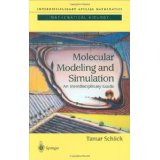 Molecular Modeling and Simulation: An Interdisciplinary Guide by Tamar Schlick, Springer, 2006.
Molecular Modeling and Simulation: An Interdisciplinary Guide by Tamar Schlick, Springer, 2006.
This book provides a discussion of mostly classical simulation exclusively motivated by problems faced in biology. The first six of fourteen chapters in the book provide well-posed statements of challenges in biology that require computational solutions. The remainder of the book introduces the modeling techniques as they are relevant to issues such as protein folding. There exists a second edition published in 2010.
|
|
|
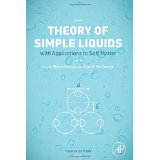 Theory of Simple Liquids by J.-P. Hansen & I.R. McDonald, 2nd Ed., Academic Press, San Diego, CA, 1986.
Theory of Simple Liquids by J.-P. Hansen & I.R. McDonald, 2nd Ed., Academic Press, San Diego, CA, 1986.
This book is an advanced statistical mechanics textbook. Chapter 7 and 8 are especially good in terms of deriving dynamic behavior from correlation functions.
|
|
Contact: Instructor
Link: Course Homepage
|
 University of Tennessee
University of Tennessee Computer Simulation of Liquids by M.P. Allen & D.J. Tildesley, Clarendon Press, Oxford, 1987.
Computer Simulation of Liquids by M.P. Allen & D.J. Tildesley, Clarendon Press, Oxford, 1987.  Molecular Dynamics Simulation: Elementary Methods by J.M. Haile, John Wiley & Sons, Inc., New York, 1992.
Molecular Dynamics Simulation: Elementary Methods by J.M. Haile, John Wiley & Sons, Inc., New York, 1992.  Understanding Molecular Simulation: From Algorithms to Applications by Daan Frenkel & Berend Smit, 2nd Ed., Academic Press, San Diego, 2002.
Understanding Molecular Simulation: From Algorithms to Applications by Daan Frenkel & Berend Smit, 2nd Ed., Academic Press, San Diego, 2002.  The Art of Molecular Dynamics Simulation by D.C. Rapaport, 2nd Ed., Cambridge University Press, Cambridge, 2004.
The Art of Molecular Dynamics Simulation by D.C. Rapaport, 2nd Ed., Cambridge University Press, Cambridge, 2004.  Molecular Modelling for Beginners by Alan Hinchliffe, 2nd Ed., John Wiley & Sons, Inc., New York, 2008.
Molecular Modelling for Beginners by Alan Hinchliffe, 2nd Ed., John Wiley & Sons, Inc., New York, 2008.  Molecular Modelling: Principles and Applications by Andrew R. Leach, 2nd Ed., Prentice Hall, Harlow, England, 2001.
Molecular Modelling: Principles and Applications by Andrew R. Leach, 2nd Ed., Prentice Hall, Harlow, England, 2001.  Molecular Modeling and Simulation: An Interdisciplinary Guide by Tamar Schlick, Springer, 2006.
Molecular Modeling and Simulation: An Interdisciplinary Guide by Tamar Schlick, Springer, 2006.  Theory of Simple Liquids by J.-P. Hansen & I.R. McDonald, 2nd Ed., Academic Press, San Diego, CA, 1986.
Theory of Simple Liquids by J.-P. Hansen & I.R. McDonald, 2nd Ed., Academic Press, San Diego, CA, 1986.